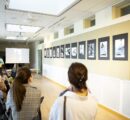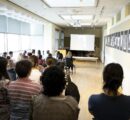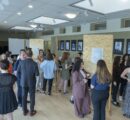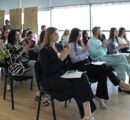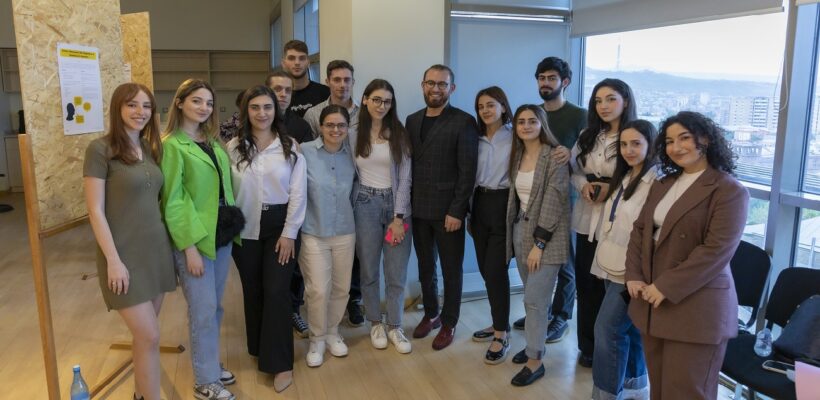
EC Seniors Present Their Capstones
3 min readYEREVAN, Armenia — On May 23 and 24, a cohort of seniors from English and Communications (EC) presented their capstone projects in the Akian Art Gallery of the American University of Armenia (AUA). Supervised by Dr. Rafik Santrosyan, the students have completed various projects, including translations, research, creative writing, internships, and visual storytelling. The projects revolved around various prevalent topics in Armenian society and beyond.
The presentations took place in the tradition of a literary salon. The first day kicked off with Dr. Santrosyan’s opening remarks in which he emphasized the importance of these soon-to-be-presented translations not only as a way of enriching the deposit of feminist works in the Armenian language but also as an expression of resistance against the linguistic hegemony of imperial languages that threaten the languages spoken by smaller nations, such as Armenian. After Dr. Santrosyan’s introduction, five of the eighteen students in the cohort read excerpts from their translations of feminist works by bell hooks, Chimamanda Ngozi Adichie, and Margaret Atwood, subsequently inviting the guests to engage in a discussion with them.
On the 24th, a set of poster presentations was exhibited in the Akian Art Gallery covering different research topics, including the discourse on militarization at Armenian schools, sexualization of women in ads, internalized victim-blaming, and a language learning app, among others. The exhibition-style format allowed the attending students, faculty, and guests to approach each project of interest to them and engage in dialogue with the students. This format afforded everyone a more meaningful way of engaging with the presenters.
Apart from tackling subjects of personal interest, the projects addressed pressing issues in Armenian society regarding gender, militarization, nationalism, and more — analyzing them through language and discursive practices. As such, the students have made an important contribution to the existing knowledge in the aforementioned topics. Moreover, some were first-of-its-kind to address their respective research questions in the Armenian context.
One of the students presented an exhibition of photographs in the Akian Art Gallery. The project problematized women’s stereotypical and collective representation in Armenian sculptures and offered an alternative look at them. The exhibition was available on both days allowing guests to view them and engage with the exhibitor over a longer period.
The works presented by students in their final semester of undergraduate studies reflected diverse and interesting subject matter. The presentations also created a forum for discussion and dialogue on the content of completed projects that reach beyond campus and may have long-lasting significance.
The names of the projects and their respective authors are listed below:
- Karen Petrosyan — Women’s Statues Exhibition
- Yelena Manukyan — Armenian translation of The Will to Change: Men, Masculinity, and Love by bell hooks
- Armenuhi Avagyan — Armenian translation of The Will to Change: Men, Masculinity, and Love by bell hooks
- Meri Sargsyan — Armenian translation of The Thing Around Your Neck by Chimamanda Ngozi Adichie
- Sofia Shakhpazyan — Armenian translation of Talking Back by bell hooks
- Ellen Hambardzumyan — Armenian translation of Margaret Atwood’s Selected Poems
- Manvel Levonyan — Novel, “Touched”
- Anna Andreasyan — Armenian Gendered Vocatives in Public Interaction
- Ani Avoyan — The Discourse of Militarization in Public Schools: Commemorative Practices
- Eduard Betanian — Putin’s Discourse on War: The Pragmatics of Questions & Answers
- Roza Chibukhchyan — App of Teaching Armenian to Autistic Language Learners
- Nirva Kuyumcu — Turkish Pragmatic Borrowings in Contemporary Istanbul Armenian
- Sona Martirosyan — Intersectional Analysis of Primary School Textbooks of Armenian
- Armine Melkonyan — Internalized Victim-Blaming Discourse in the Armenian Context
- Mane Solomonyan — Multimodal Discourse Analysis of Women’s Sexualization in Armenian Advertisements on Instagram
- Alexandre Takvorian — The Discourse of Appropriation: Azerbaijani Misattribution of Persian Architectural Heritage of Yerevan
- Lilith Tamazyan — Trivialization of War through Reinforcement of Gender Norms
- Armen Vardanyan — Internship, CSN, Project: “Relocated Russian Culture: The Case of the South Caucasus (Armenia, Georgia)”
Founded in 1991, the American University of Armenia (AUA) is a private, independent university located in Yerevan, Armenia, affiliated with the University of California, and accredited by the WASC Senior College and University Commission in the United States. AUA provides local and international students with Western-style education through top-quality undergraduate, graduate, and certificate programs, promotes research and innovation, encourages civic engagement and community service, and fosters democratic values.

